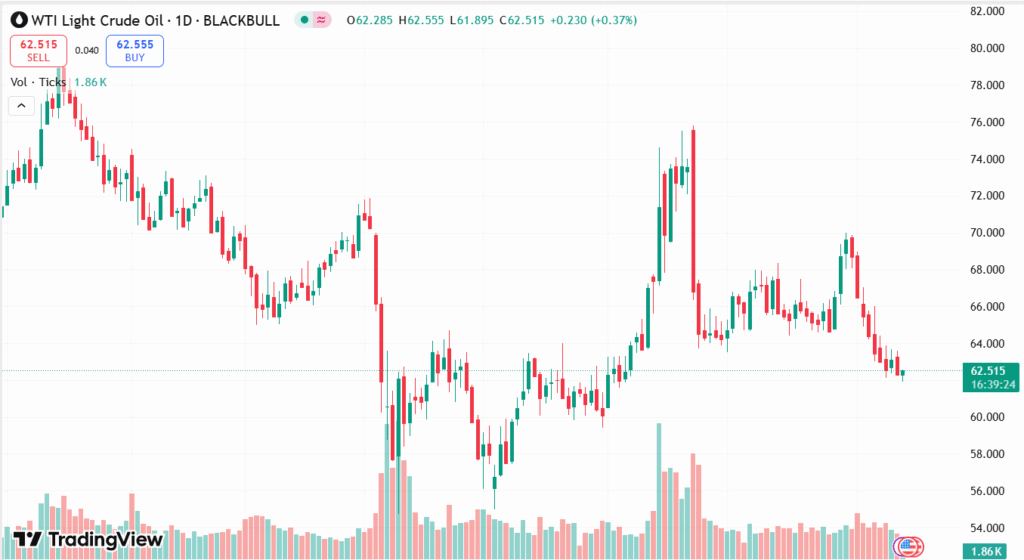West Texas Intermediate (WTI) crude oil prices fell below $63 on Tuesday as the Energy Information Administration’s (EIA) latest report forecasted record US production and increasing global supply. The EIA now expects US crude output to peak near 13.6 million barrels per day by December 2025, with global inventories building by an average of 2 million bpd through early 2026. Coupled with easing OPEC+ quota restrictions and potential progress toward a US-brokered Russia-Ukraine ceasefire, market sentiment has turned bearish, keeping WTI prices trapped in a consolidation range between $62 and $64, well below the 200-day EMA.
KEY LOOKOUTS
• Crude fell below $63, between $62–$64 on soft buying pressure.
• US crude output to rise to a high of 13.6 million bpd by December 2025.
• Stockpiles to increase by 2 million bpd during Q4 2025–Q1 2026, with Brent to ease to $50 by early 2026.
• Any US-facilitated Russia-Ukraine ceasefire negotiations may also put additional pressure on crude prices.

Crude prices dipped on Tuesday, with West Texas Intermediate (WTI) falling below the $63 threshold as supply pressures push down on sentiment. The Energy Information Administration’s (EIA) revised forecast puts US crude output at a record 13.6 million bpd in December 2025, as global inventories are anticipated to increase by an average of 2 million bpd by early 2026. The combination with the lifting of OPEC+ quota constraints and continuing geopolitics for a potential US-mediated Russia-Ukraine ceasefire has maintained WTI within a tight consolidation band at $62-$64, well below its 200-day EMA.
WTI crude dropped below $63 on Tuesday as the EIA estimated record US production and increasing global stockpiles through early 2026. Weakening OPEC+ curbs and likely Russia-Ukraine ceasefire negotiations also pushed prices lower, confining WTI to a $62–$64 consolidation range.
• WTI crude dropped below $63, ranging in a $62–$64 consolidation base.
• EIA estimates US crude production reaching a record 13.6 million bpd by December of 2025.
• Global crude stockpiles poised to increase by 2 million bpd over Q1 2026.
• Brent crude prices seen falling to $50 per barrel by 2026.
• Supply growth fueled by more wells and rising US drilling activity.
• Relaxation of OPEC+ quota curbs further adding to global supply pressure.
• Speculative possibility of US-brokered Russia-Ukraine ceasefire discussions shaping market sentiment.
West Texas Intermediate (WTI) crude prices were in bearish pressure on Tuesday after the Energy Information Administration (EIA) published its new Short-Term Energy Outlook. The agency now sees US crude production reaching an all-time high of 13.6 million barrels per day by December 2025, backed by higher drilling activity and climbing well counts. Global supply is also expected to grow, with inventories increasing by an average of 2 million barrels per day up until late 2025 and early 2026. Easing OPEC+ production restraint is also expected by the EIA to add to the increasing supply surplus in the market.
WTI CRUDE OIL DAILY PRICE CHART

SOURCE: TradingView
Geopolitical events are also influencing attitudes, with US President Donald Trump playing a role as the prime broker in prospective Russia-Ukraine ceasefire negotiations. Although an immediate solution is unlikely, the potential for a breakthrough has contributed to the market’s conservative view. While energy traders consider the implications of increasing production, as well as possible changes in global political alignments, the wider oil market will be keeping an eye on production trends, diplomatic talks, and OPEC+ policy actions that will potentially shape supply conditions up to 2026.
TECHNICAL ANALYSIS
WTI crude is consolidating in a tight range between $62 and $64, still below the 200-day Exponential Moving Average (EMA) situated around $67.50. Bearish momentum is subdued, with sellers thus far failing to break below the essential $60 support, while the conviction of buyers to fuel a lasting reversal is missing. Such range-bound activity portends that a conclusive breakout in either direction is bound to take a new fundamental impetus, for example, a major supply disruption or a change in policy by OPEC+.

FORECAST
Forward-looking, WTI crude oil prices can expect to remain under downward pressure if US output consistently increases as expected and global stockpiles increase further. The loosening of OPEC+ quota restraints alongside rising supply from US shale can keep near-term price increases contained. Furthermore, any steps toward a Russia-Ukraine ceasefire can put downward pressure on prices by reducing geopolitical risk premiums.
Yet prices would bounce if there are unforeseen supply shocks, like renewed geopolitical tensions or curtailment of production by key oil producers. Additionally, greater-than-anticipated global demand or any slowdown in US drilling activity would tighten supply and help reverse the price back over $64–$65. Traders will be looking closely at coming inventory reports, OPEC+ actions, and geopolitics for indications of the next move.







